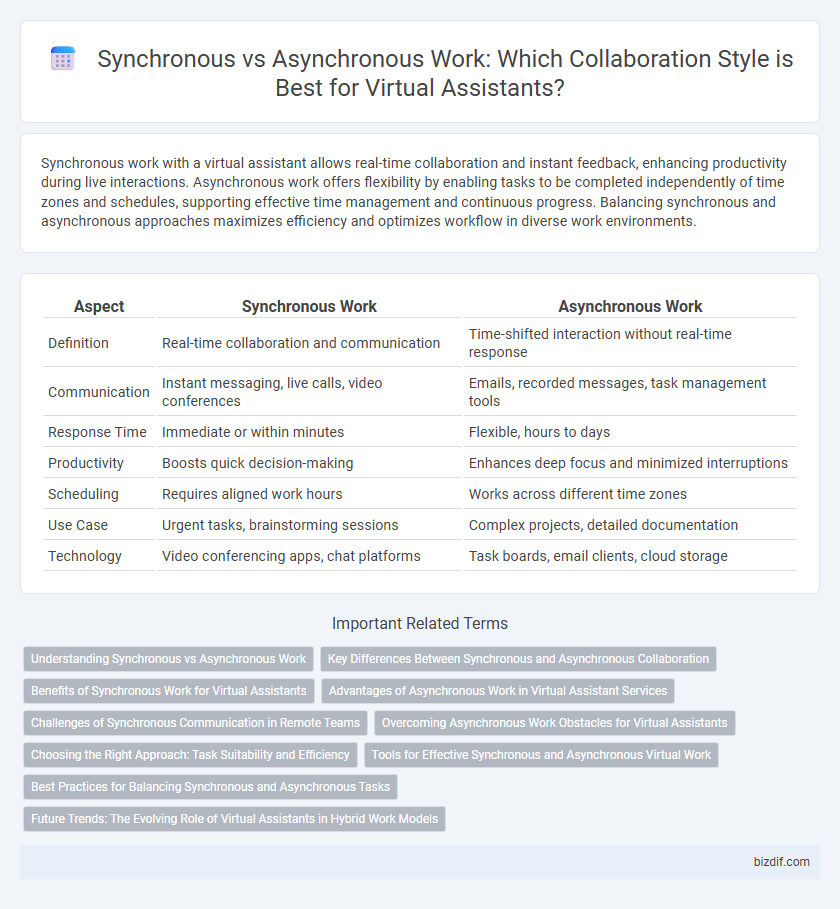Synchronous work with a virtual assistant allows real-time collaboration and instant feedback, enhancing productivity during live interactions. Asynchronous work offers flexibility by enabling tasks to be completed independently of time zones and schedules, supporting effective time management and continuous progress. Balancing synchronous and asynchronous approaches maximizes efficiency and optimizes workflow in diverse work environments.
Table of Comparison
| Aspect | Synchronous Work | Asynchronous Work |
|---|---|---|
| Definition | Real-time collaboration and communication | Time-shifted interaction without real-time response |
| Communication | Instant messaging, live calls, video conferences | Emails, recorded messages, task management tools |
| Response Time | Immediate or within minutes | Flexible, hours to days |
| Productivity | Boosts quick decision-making | Enhances deep focus and minimized interruptions |
| Scheduling | Requires aligned work hours | Works across different time zones |
| Use Case | Urgent tasks, brainstorming sessions | Complex projects, detailed documentation |
| Technology | Video conferencing apps, chat platforms | Task boards, email clients, cloud storage |
Understanding Synchronous vs Asynchronous Work
Synchronous work involves real-time communication and collaboration, where all participants engage simultaneously, enhancing immediate feedback and dynamic interactions. Asynchronous work allows individuals to complete tasks on their own schedules without requiring instant responses, promoting flexibility and deeper focus. Virtual assistants facilitate both methods by managing schedules for synchronous meetings and organizing tasks or messages for asynchronous workflows.
Key Differences Between Synchronous and Asynchronous Collaboration
Synchronous work requires real-time interaction, enabling immediate feedback and dynamic communication ideal for virtual assistants managing live schedules or urgent tasks. Asynchronous work allows team members to contribute independently on their own time, promoting flexibility and thoughtful responses, essential for detailed project documentation or research. Key differences include immediate collaboration in synchronous settings versus time-shifted communication in asynchronous methods, impacting productivity, decision-making speed, and workflow management.
Benefits of Synchronous Work for Virtual Assistants
Synchronous work enables virtual assistants to provide real-time support, enhancing communication efficiency and reducing misunderstandings. This immediate interaction facilitates quicker decision-making and problem-solving, which is crucial for time-sensitive tasks. Access to instant feedback also allows virtual assistants to adapt swiftly to client needs, improving overall productivity and service quality.
Advantages of Asynchronous Work in Virtual Assistant Services
Asynchronous work in virtual assistant services enables increased flexibility by allowing tasks to be completed without requiring simultaneous communication, which enhances productivity across different time zones. This approach reduces interruptions, enabling virtual assistants to focus deeply and deliver higher-quality outputs. It also promotes better time management and scalability by accommodating varied schedules and priorities.
Challenges of Synchronous Communication in Remote Teams
Synchronous communication in remote teams often leads to scheduling conflicts due to different time zones, reducing overall productivity and causing delays. Real-time meetings require immediate attention, which can interrupt deep work and increase cognitive load. The challenge of maintaining engagement and clear communication in virtual meetings frequently results in misunderstandings and decreased collaboration efficiency.
Overcoming Asynchronous Work Obstacles for Virtual Assistants
Virtual assistants face challenges in asynchronous work such as delayed communication, lack of immediate feedback, and difficulty in maintaining team cohesion. Overcoming these obstacles requires implementing clear task management tools, setting explicit deadlines, and fostering regular progress updates through collaborative platforms like Slack or Trello. Prioritizing transparent communication and consistent check-ins enhances productivity and ensures alignment in remote virtual assistant teams.
Choosing the Right Approach: Task Suitability and Efficiency
Choosing the right approach between synchronous and asynchronous work depends on task suitability and efficiency, with synchronous work excelling in real-time collaboration and immediate decision-making, especially for complex or urgent tasks. Asynchronous work offers flexibility and allows for deep focus, making it ideal for tasks requiring reflection, research, or contributions across different time zones. Virtual assistants can optimize productivity by aligning work styles with task requirements, leveraging synchronous methods for dynamic interactions and asynchronous methods for independent, time-flexible assignments.
Tools for Effective Synchronous and Asynchronous Virtual Work
Tools like Microsoft Teams, Zoom, and Google Meet enable effective synchronous virtual work by facilitating real-time communication and collaboration. Asynchronous virtual work benefits from platforms such as Slack, Trello, and Asana, which support task management and messaging without immediate responses. Integrating both synchronous and asynchronous tools enhances productivity, allowing teams to balance immediate interaction with flexible, time-independent workflows.
Best Practices for Balancing Synchronous and Asynchronous Tasks
Balancing synchronous and asynchronous tasks in virtual assistant workflows requires defining clear priorities and communication guidelines to maximize productivity. Establish scheduled meetings and real-time check-ins for urgent issues, while leveraging task management tools and detailed updates for asynchronous work to minimize distractions. Optimizing this balance enhances collaboration, reduces response delays, and supports efficient time management in remote environments.
Future Trends: The Evolving Role of Virtual Assistants in Hybrid Work Models
Virtual assistants are rapidly adapting to hybrid work models by enabling seamless synchronous collaboration through real-time scheduling, video conferencing support, and instant messaging integration. Concurrently, they enhance asynchronous workflows by managing task prioritization, automating follow-ups, and providing data-driven insights for remote teams working across different time zones. Future trends indicate a growing reliance on AI-powered virtual assistants to balance synchronous and asynchronous demands, optimizing productivity and communication efficiency in dynamic hybrid environments.
Synchronous work vs Asynchronous work Infographic

 bizdif.com
bizdif.com